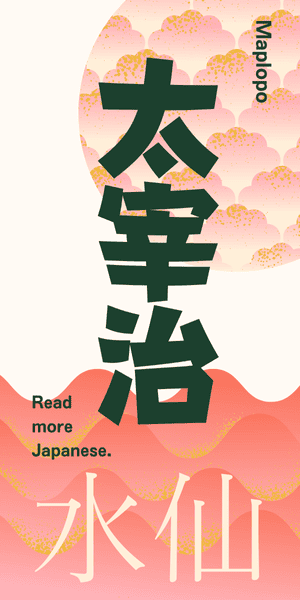Maplopo Program Tour
Intermediate Japanese Learning with Dazai Osamu
Complimentary Japanese Reading Lessons
Season ONE—水仙 (Page FIFTEEN)
EP.15 Spotlight: れる、られる, Dazai Osamu (太宰治), Daffodil (水仙)
Video file / Audio File / Online Intermediate Japanese Course
れる, られる, EP.15 Transcript | Intermediate and Advanced Japanese
れる, られる
It’s a powerhouse. It shows up in passive voice…, when discussing ability (or a lack thereof)…,
with spontaneous passive…, and… when we want to employ respect language.
Today, though…, we’re gonna cover れる, られる from the perspective of Dazai’s usage in this particular paragraph—paragraph three. Simply, passive.
Now, I say simply…, …but, of course, there’s nothing simple about passive voice—especially if your first language is English, and the passive is just not as front-and-center as it is in Japanese. It can be a tricky bugger to wrap our heads around at times, but we can get there. Let’s do a bit of that.
With Japanese, to understand passive voice is to get closer to the language on a deeper level. And, the more we study it…, the more we work at using it…, then the more adept we’ll become a t maneuvering through its turns without getting caught on the burrs. We’ll also better internalize the language, because the passive is more than a way to make sentences, it’s a mindset. And its footing in the language owes credit to cultural ideals and thinking that have matured over great swaths of time.
This mindset is… (for those who grow up in the culture of Japan…, speaking the language, and living within its society…) a way of looking at the world wherein one considers themselves to be a participant in an almost… layered world… …one where the existence of the self is surrounded by that which occupies the “world”: people, things, nature, and so forth.
With this concept one gravitates toward the idea that one’s existence is, in a way, governed, or influenced by that which is beyond them… .. it’s a feeling, or an internal sense…, an awareness of a dominating force exerting a certain control over the self.
The acceptance of this feeling without pushing back…, to somewhat go with nature’s course, is to occupy this mindset. It’s a view that allows for a greater recognition of things just “happening” without intention or desire to influence. It’s an embrace of life as it is.
We saw this on display in our discussion of まま as well… the beauty of surrendering to something beyond us without a smidge of rebellion… of leaving things to the mercy of the wind.
This type of engrained passive psychology (or, mindset) aided the development of passive expression in Japanese.
This is part of why we see a number of passive-only verbs in Japanese.
…verbs that wouldn’t be used in active voice…, …verbs like うなされる for example, which we use to talk about the experience of having a really bad dream…
悪夢にうなされる
So, in Japanese we wouldn’t say: 悪夢がうなす It’s always: 悪夢にうなされる
Each of these examples can only exist as passive voice verbs.
Proverbs, aphorisms, and familiar everyday expressions, as well, help drive this comfort for NOT siding with the active-agent, but with the receiver:
Alright.
So, let’s dive into four situations where the passive voice structure is…

